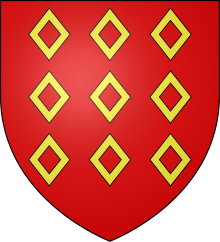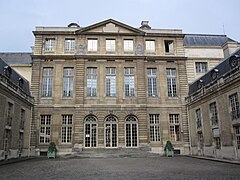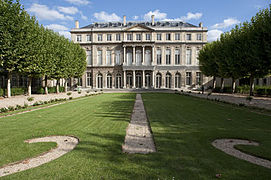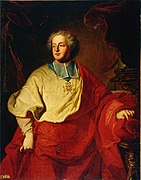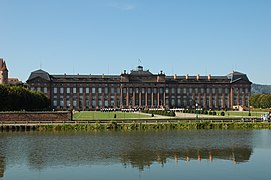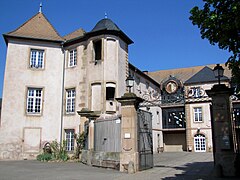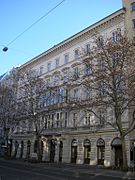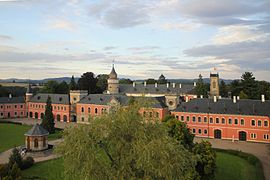Rohan (noble family)
Rohan is a French aristocratic family with significant influence on the country's history. It was the most powerful family in Brittany , along with House Clisson and House Laval .
General
The Rohan trace their family back to the Breton kings. What is certain, however, is that they descended from the Vice Counts of Porhoët . In the Middle Ages the Viscounts de Rohan allied themselves several times with the Dukes of Brittany , most recently in 1407.
In the 18th century, four cardinals from the Rohan family succeeded each other as Prince-Bishops of Strasbourg .
The origins
The Rohan descend from the Vice Counts of Porhoët and - following the family genealogist Pierre-Hyacinthe Morice de Beaubois (Dom Morice) - from the mythical Breton King Conan Meriadoc . The oldest known family member is Guethenoc, who had Josselin Castle built, which is already part of the Rohan family, although it was only his great-grandson who bore the name.
Guethenoc is the father of Josselin, who took part in the Norman conquest of England and the Battle of Hastings . He received for it lands in Bedfordshire , Buckinghamshire and Gloucestershire , including the city of Caerwent . He died in 1074.
Josselin's son Eudon I of Porhoët († after 1092) married Emma de Léon, daughter of the Vice Count of Léon ; their sons were the vice counts Geoffroy, Josselin and Alain I. de Rohan, Vicomte de Castelnoec († 1128). Geoffroy's son Eudon II of Porhoët was Duke of Brittany from 1148 to 1156 as regent for his wife Bertha. Geoffroy's second son was Alain I. de la Ceoche , who is recorded in England from 1172 and died there in 1190. His descendants are the La Zouche , who died out in 1799.
Alain I., the youngest, is the builder of Rohan Castle , after which he was named, and the progenitor of the Rohan family. His son Alain II. De Rohan († after 1168) was the first to hold the title Viscount de Rohan .
The Rohan in the Middle Ages and the Renaissance
The Rohan family held this title for ten generations before Alain IX. de Rohan († 1462) got the county of Porhoët back as the grandson of Olivier V. de Clisson . With his grandson Jacques I. de Rohan, the line then went out in 1527.
At the same time, however, the rise of the descendants of a cousin Alains IX., Lord of Guéméné , Louis I de Rohan († 1457), who emerged from the second marriage of their grandfather Jean I de Rohan, began . With the sons of Louis I, this branch split into two lines, the older line Rohan-Gié ( Pierre I. de Rohan became Prince de Rohan in 1485, his descendant Henri II. 1603 Duc de Rohan) and the younger line Rohan-Guéméné (1570 Prince de Guéméné, 1594 Duc de Montbazon).
The division of the family
Rohan Chabot
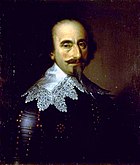
In 1604, King Henry IV raised his cousin, Prince Henri II de Rohan , to Duke of Rohan and thus made the Vice-County of Rohan a duchy. However, the new duke moved his seat from Rohan to the Château de Pontivy , which his grandfather Jean II. De Rohan had built. He married the daughter of the powerful minister Sully in 1605 and became the military leader of the Huguenots in France after the assassination of King Henry IV in 1610 .
After his death in 1638, his great inheritance fell to his only surviving daughter Marguerite de Rohan (1617–1684). Despite numerous applicants for marriage, some of royal blood, she entered into a love affair with the penniless Catholic petty aristocracy Henri de Chabot (1615–1655) from Poitou in 1645 . She achieved against the resistance of the younger Rohan line that her husband was raised to the 2nd Duke of Rohan and her illustrious family name was passed on to her children, creating the Rohan-Chabot family (of the Chabot male tribe ). This family is still based at Castle Josselin in Brittany, a branch that was recently married at Château de Bonnefontaine in Antrain . Also, the Château de La Motte-Tilly belonged in the 20th century the family Rohan-Chabot.
Rohan-Guéméné-Montbazon-Soubise
The younger line of the Rohan was raised to Prince de Guéméné since 1570 , Duke of Montbazon and Peer of France since 1594, and Prince de Soubise since 1667 . It provided four prince-bishops of Strasbourg. After a bankruptcy in 1783, shortly before the French Revolution, it emigrated to Bohemia and Austria, where it is still flourishing today.
Château de Pontivy , headquarters of the Dukes of Rohan from 1604
Hotel de Rohan (Paris)
The "Princes étrangers"
From the 17th century onwards, the Rohan used their supposedly royal Breton origins not only to rise to a princely rank, but also to receive a rank as princes étrangers that surpassed that of dukes and pairs. Their goal was on the one hand to prove the sovereignty of the old Breton kings, on the other hand their direct descent from them - hence the use of the first name Mériadec in the family.
Both statements are not obvious and even controversial. The Rohan tried to underpin their view of things through genealogists like Dom Morice, but also to enforce it simply through their power and wealth, that is, to distort history in their own way - a common practice in the families of the Ancien Régime . The Rohan secured their claim and their position
- Marriage alliances with the other "foreign princely families" (from Lorraine ( House Châtenois ), the Duchy of Bouillon ( La Tour d'Auvergne ), the Condé ),
- Elevation of their land holdings to principalities ( Guéméné , Soubise , Pays de Léon ), as well as the appointment to bishops of Strasbourg and thus imperial princes, and
- their proximity to the kings Louis XIV ( Madame de Soubise ), Louis XV. ( Maréchal de Soubise ) and Louis XVI. (Madame de Marsan, the Marshal's sister and tutor to the King's sisters, and Madame de Guéméné , tutor to the children of Louis XVI).
The Prince-Bishops of Strasbourg
In the 18th century, four cardinals from the Rohan family succeeded each other as Prince-Bishops of Strasbourg :
- Armand I. Gaston Maximilien de Rohan-Soubise (1674–1749), 1704 Bishop of Strasbourg, 1713 Grand Almosier of France
- Armand II. François Auguste de Rohan-Soubise (1717–1756)
- Louis César Constantin de Rohan-Guéméné (1697–1779) and
- Louis René Édouard de Rohan-Guéméné (1734–1803), 1777 Grand Almosier of France
Armand I. Gaston Maximilien de Rohan-Soubise (1674–1749)
Armand II. François Auguste de Rohan-Soubise (1717–1756)
Louis César Constantin de Rohan-Guéméné (1697–1779)
Louis René Édouard de Rohan-Guéméné (1734–1803)
Other important church princes from the family were:
- Armand Jules de Rohan-Guéméné (1695–1762), Archbishop of Reims , the Louis XV. crowned,
- Ferdinand Maximilien Mériadec de Rohan-Guéméné (1738–1813), 1769–1781 Archbishop of Bordeaux , the first chaplain of the Empresses Joséphine and Marie Louise
Prince-Bishop's Palais Rohan (Strasbourg)
Prince-Bishop Rohan Castle ( Saverne in Alsace )
Prince-Bishop's Castle in Mutzig
Bankruptcy and emigration to Austria and Bohemia
On the eve of the French Revolution in 1783, Jules Hercule Mériadec de Rohan, prince de Guéméné , went bankrupt, a scandal that was only exceeded in 1785 by the involvement of his brother, Cardinal Louis René Édouard de Rohan, in the collar affair. The bankrupt's family emigrated to Austria, where they were soon naturalized. In 1816 his grandson was awarded the old title of Duc de Bouillon by the Congress of Vienna because of his relationship with the La Tour d'Auvergne family . In 1820 Charles Alain de Rohan u. a. the Bohemian dominions of Sychrov , Svijany , Český Dub and Turnov , of which u. a. the Rohanstein on the Jeschken near Liberec testifies. On January 1, 1834, he acquired from Ignaz Falge jun. the Lomnice estate and the Čistá estate .
When the line died out in 1846, the younger branch of the Rohan-Guéméné, the Princes of Rochefort , inherited the titles of Prince Rohan, Prince de Guéméné, Duc de Montbazon and Duc de Bouillon, etc., as well as the Bohemian goods that they acquired in 1945 in the course of the Beneš - Decrees lost again.
Rohan-Gué de l'Isle and Rohan-Poulduc
The Rohan-Gué de l'Isle branch was founded around 1270 with a younger son of Alain VI. de Rohan and is named after Saint-Étienne-du-Gué-de-l'Isle . It became extinct in 1554. The little-known branch Rohan-Poulduc (or Rohan-Poldu), which is named after Pouldu near Pontivy , which today belongs to Saint-Jean-Brévelay , split off from it. The best known member of this family is Emmanuel de Rohan-Polduc , Grand Master of the Order of Malta from 1775 to 1797. He went out in 1800.
literature
- Constantin von Wurzbach : Rohan, the princes, genealogy . In: Biographisches Lexikon des Kaiserthums Oesterreich . 26th part. Imperial-Royal Court and State Printing Office, Vienna 1874, p. 276 f. ( Digitized version ).
- Constantin von Wurzbach : Rohan, the princes, coat of arms . In: Biographisches Lexikon des Kaiserthums Oesterreich . 26th part. Imperial-Royal Court and State Printing House, Vienna 1874, p. 279 ( digitized version ).
- Constantin von Wurzbach : Rohan-Guémenée and Rohan-Rochefort-Montauban, the princes, family table . In: Biographisches Lexikon des Kaiserthums Oesterreich . 26th part. Imperial and Royal Court and State Printing Office, Vienna 1874, p. 421 ( digitized version ).
- Detlev Schwennicke: European Family Tables Volume X (1986) Table 13 ff.
